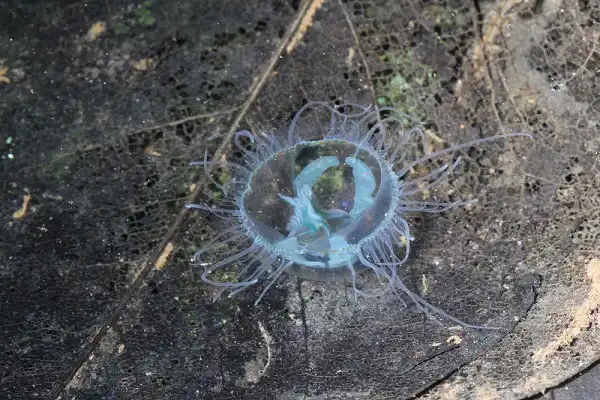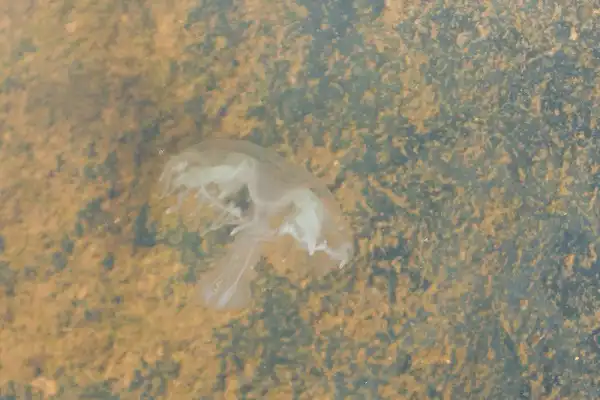Have you ever stopped to consider the marine life living in rivers and freshwater streams near you? You might be surprised to learn that one such creature present in these aquatic habitats is the freshwater jellyfish. While we traditionally associate jellyfish with oceanic environments, freshwater varieties exist and may provide a crucial out-of-the-box solution for balancing small water ecosystems. Let’s take a closer look at this lesser-known organism—including what they are, where they live, why they matter, and more!

Freshwater Jellyfish Description
Freshwater jellyfish are fascinating creatures that come in a variety of shapes and sizes. Although traditionally associated with oceanic environments, these jellyfish are adapted to survive in freshwater ecosystems. They have bell-shaped bodies. Freshwater Jellyfish have no distinct head but instead have 2 simple eyespots located at the base of their bell-shaped body. Their bodies consist of 99% water and can range from pale yellowish green to bright white in color.
Freshwater Jellyfish Habitat
Freshwater Jellyfish inhabit a variety of habitats including lakes, ponds, rivers, streams and even underground aquifers. They are typically found in shallow, still waters with plenty of sunlight and abundant food sources like plankton. However, they can also be spotted in slow-moving river backwaters or marshy areas where they take advantage of the increased food supply as well as protection from predators. These incredible creatures have adapted to survive in almost any type of freshwater environment. In some cases, they can even tolerate slightly brackish water conditions such as those found along coastlines and estuaries near the sea. The jellyfish can also be found at depths up to 300 meters below the surface in deep lakes and rivers around the world! Due to their unique ability to withstand a range of environmental conditions, Freshwater Jellyfish are able to colonize new habitats quickly—at times even forming large blooms that can cover entire bodies of water for short periods of time. This rapid colonizing rate is one reason why these creatures are so important for maintaining healthy aquatic ecosystems; they act as natural biofilters by consuming excessive amounts of algae or decaying organic matter which could otherwise lead to oxygen depletion and eventually harm other species living in the area.
Freshwater Jellyfish Diet
Freshwater Jellyfish mainly feed on zooplankton, phytoplankton, and other small organisms such as nematodes or rotifers. These jellyfish use their cnidocytes (stinging cells) to capture prey and defend against predators. They have evolved to survive in a variety of habitats, but they prefer still waters with lots of sunlight and abundant food sources like plankton. Once the food is captured, it is then digested by an enzyme-filled substance called gastrodermis which is found within the bell-shaped body of the jellyfish. The gastrodermis breaks down the prey into small particles that are absorbed directly through the body wall and used for energy production. The jellyfish can also store excess energy in its tissues in the form of lipids which can be used during periods of starvation or when food is scarce.

Freshwater Jellyfish Size
The size of Freshwater Jellyfish can vary greatly depending on the species, but they usually range from around 5 millimeters to 10 centimeters in diameter. The bell of the jellyfish is generally composed of thin, transparent gelatinous material and may contain bands or spots which help the creature move through the water. They have a set of eight lengthy tentacles that radiate from its body which can be used to capture prey or ward off potential predators. Unlike their marine counterparts, Freshwater Jellyfish are much less likely to reach larger sizes since they lack the complex food webs found in saltwater ecosystems. However, some species have been known to reach up to 25 centimeters in diameter! These creatures often display fascinating bioluminescence abilities which can make them appear more brightly colored under certain light conditions.
Freshwater Jellyfish Lifespan
The lifespan of freshwater jellyfish is incredibly variable and can range from just a few weeks to multiple years. Generally speaking, most species live for between one and 6 months depending on environmental conditions such as temperature, oxygen levels, and food availability. However, some species have been known to survive for up to 2 years with regular reproduction cycles if environmental conditions remain favorable. In addition to these environmental factors, the age of the individual jellyfish can also affect its lifespan. In particular, younger jellyfish tend to have shorter lifespans due to their higher vulnerability and lack of experience with predation pressure. On the other hand, older individuals are more likely to survive for longer periods of time as they are better adapted to their environment.
Freshwater Jellyfish Behavior
Freshwater Jellyfish have a variety of different behaviors that help them survive in the wild. They are primarily passive hunters, meaning they use their tentacles to capture prey from the water without actively pursuing it. This method is particularly useful for species living in smaller bodies of water since they lack the energy and resources to pursue large and active prey. Freshwater Jellyfish can move around by pulsating their bell-shaped bodies, propelling themselves through the water with each contraction. Additionally, some species can spin around rapidly on a vertical axis which allows them to quickly ascend or descend in search of food sources or shelter from predators. These creatures often display fascinating bioluminescent abilities which can make them appear more brightly colored under certain light conditions. This behavior is thought to be used as a form of communication between jellyfish as well as for defense against potential predators.
Freshwater Jellyfish Speed
Freshwater Jellyfish are capable of propelling themselves through the water at surprisingly fast speeds. Depending on the species, they can reach up to 1 meter per second, which is considered to be an impressive speed for a creature their size. By rapidly pulsating their bell-shaped bodies, jellyfish are able to generate a hydrodynamic thrust that propels them forward. In addition to this rapid swimming ability, some species have also been observed spinning around rapidly on a vertical axis which helps them ascend or descend in search of food sources or shelter from predators. This behavior is known as “vertical jetting” and is thought to be used as a defensive adaptation for the purpose of quickly evading predators.

Freshwater Jellyfish Hunting
Freshwater Jellyfish are voracious predators, with their tentacles ready to capture unsuspecting prey. They use their long tentacles to sense changes in the water and quickly extend them to capture unsuspecting organisms such as zooplankton, larvae, and crustaceans. The jellyfish then uses its tentacles to trap the prey before pushing it towards its mouth or so-called “oral arms” which take the food down into its digestive system. In addition to being an active hunter, the Freshwater Jellyfish is also an opportunistic feeder that takes advantage of decaying organic matter or detritus found in their environment. This helps keep their environment clean and healthy for other species living in close proximity. To take advantage of this type of food source, these jellyfish often display unique bioluminescent abilities which allows them to find food sources much more easily since they appear brighter when in darker environments. Overall, Freshwater Jellyfish are highly adaptable predators that play an important role in maintaining healthy aquatic ecosystems by helping keep populations of algae or debris under control which could otherwise lead to oxygen depletion and harm other species living in close proximity.
Freshwater Jellyfish Life Cycle and Reproduction
Freshwater Jellyfish go through a complex life cycle that involves both polyp and medusa stages. During their life cycle, they can reproduce either sexually or asexually depending on the species and the environmental conditions they are exposed to. The sexual reproduction process begins when two jellyfish come together and release their gametes into the water where fertilization takes place. Once fertilized, the eggs develop into ciliated larvae known as planulae that eventually settle and attach to a solid surface, typically on the substrate of a stream or lake. After settling, they transform into sessile polyps which form colonies by budding off new polyps from their tentacles. The polyp stage of the jellyfish life cycle is relatively short and can last from a few days to a few weeks. During this time, these polyps reproduce asexually through the process of budding off small clones known as ephryae which detach from the colony and swim away. The ephryae will then metamorphose into medusa, the juvenile form of a jellyfish.
Freshwater Jellyfish Predators and Threats
Freshwater jellyfish, like their marine counterparts, have many predators. Some of these include other jellyfish, crustaceans, fish, turtles, and even birds. They are also threatened by humans due to water pollution and overfishing which can create dangerous environments for these delicate creatures. Additionally, some of the native species of freshwater jellyfish may be hurt by the introduction of non-native species. As a result, conservation efforts are often focused on protecting these fragile creatures and their habitats so that they can continue to thrive in the wild. These gametes come together during fertilization, which then results in the birth of hundreds or thousands of tiny jellyfish known as planulae. These newborn jellyfish then seek out suitable habitats and begin to grow and mature. The cycle is then repeated as new generations of jellyfish emerge in the wild. It is important that freshwater jellyfish are carefully monitored and protected, given their delicate nature. Many conservation efforts have been undertaken in order to preserve these species for future generations. These efforts can include habitat protection, reintroduction programs, and the elimination of non-native species that may pose a threat to the native jellyfish population.

Conclusion
Freshwater Jellyfish are fascinating creatures with the capability of rapidly propelling themselves through the water in order to capture prey or evade potential predators. This makes them an important part of maintaining healthy aquatic ecosystems by helping keep populations of algae or decaying organic matter in check which could otherwise lead to oxygen depletion and harm other species living in close proximity. In addition, Freshwater Jellyfish also display unique bioluminescent abilities as well as jet propulsion techniques which allow them to move quickly through the water and take advantage of food sources more easily. All in all, these jellyfish provide a great example of how adaptation plays an important role in survival and the maintenance of delicate aquatic ecosystems.
Frequently Asked Question


